Name Kingston Laid down 12 December 1994 Homeport CFB Halifax Construction started 12 December 1994 Length 55 m Builder Halifax Shipyard | Namesake Kingston, Ontario Commissioned 21 September 1996 Identification MM 700 Launched 12 August 1995 Draft 3.4 m | |
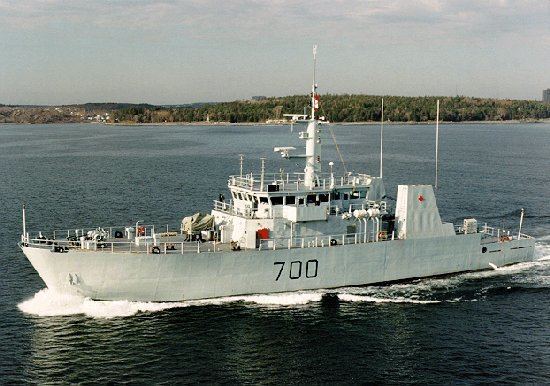 | ||
HMCS Kingston is a Kingston-class coastal defence vessel that has served in the Canadian Forces since 1996. Kingston is the lead ship of her class which is the name for the Maritime Coastal Defence Vessel Project. She is the first vessel to use the designation HMCS Kingston. She is assigned to Maritime Forces Atlantic (MARLANT) and is homeported at CFB Halifax.
Contents
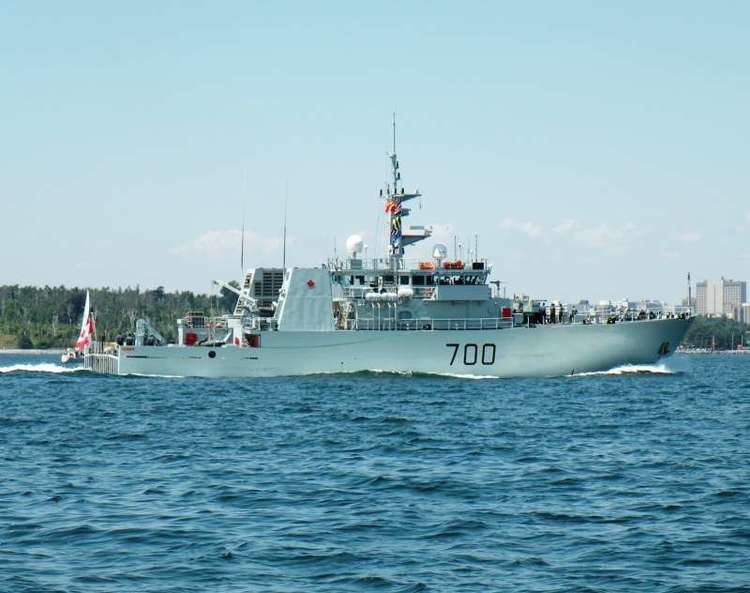
Design and description
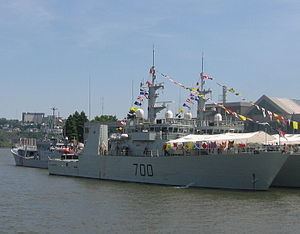
The Kingston class was designed to fill the minesweeper, coastal patrol and reserve training needs of the Canadian Forces, replacing the Bay-class minesweepers, Porte-class gate vessels and Royal Canadian Mounted Police coastal launches in those roles. In order to perform these varied duties the Kingston-class vessels are designed to carry up to three 6.1-metre (20 ft) ISO containers with power hookups on the open deck aft in order to embark mission-specific payloads. The seven module types available for embarkation include four route survey, two mechanical minesweeping and one bottom inspection modules.
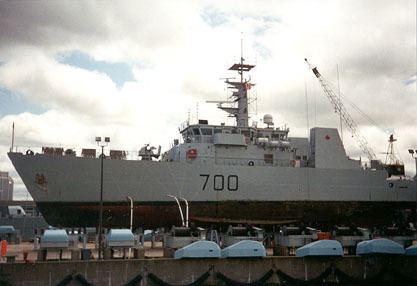
The Kingston class displace 970 long tons (990 t) and are 55.3 metres (181 ft 5 in) long overall with a beam 11.3 metres (37 ft 1 in) and a draught of 3.4 metres (11 ft 2 in). The coastal defence vessels are powered by four Jeumont ANR-53-50 alternators coupled to four Wärtsilä UD 23V12 diesel engines creating 7.2 megawatts (9,700 hp). Two LIPS Z-drive azimuth thrusters are driven by two Jeumont CI 560L motors creating 3,000 horsepower (2,200 kW) and the Z drives can be rotated 360°. This gives the ships a maximum speed of 15 knots (28 km/h; 17 mph) and a range of 5,000 nautical miles (9,300 km; 5,800 mi) at 8 knots (15 km/h; 9.2 mph).
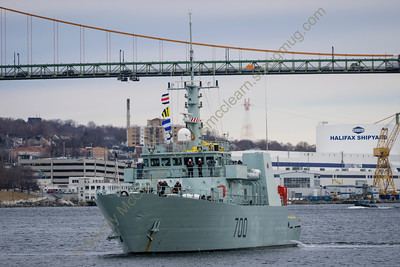
The Kingston class is equipped with a Kelvin Hughes navigational radar using the I band and a Kelvin Hughes 6000 surface search radar scanning the E and F bands. The vessels carry an AN/SQS-511 towed side scan sonar for minesweeping and a Remote-control Mine Hunting System (RMHS). The vessels are equipped with one Bofors 40 mm/60 calibre Mk 5C gun and two M2 machine guns. The Kingston-class coastal defence vessels have a complement of 37.
Service history
Kingston was laid down on 12 December 1994 at Halifax Shipyards Ltd., Halifax, Nova Scotia and was launched on 12 August 1995. The first ship to be constructed at Halifax in 32 years, Kingston was commissioned into the Canadian Forces at Kingston, Ontario on 21 September 1996 and carries the hull classification number MM 700.
In March 1999, the coastal defence vessel sailed to the Baltic Sea to participate in the NATO naval exercise "Blue Game" with sister ship Glace Bay and Anticosti.
In 2011, Kingston was among the Royal Canadian Navy vessels deployed to the Caribbean Sea as part of Operation Caribbe, Canada's contribution to Operation Martillo, the multinational effort to eliminate illegal trafficking in the Caribbean Sea and the eastern Pacific Ocean. In total, 201 metric tons were interdicted that year, in which Kingston played a part. In 2012, Kingston was assigned again to Operation Carribe. That year Operation Martillo seized 152 tons of cocaine and several million dollars in cash.
In June 2013, Kingston and Glace Bay were sent on a seven-week tour of the Saint Lawrence Seaway and the Great Lakes, making several port calls along the way. In 2014, she returned to serve in Operation Caribbe. In the summer of 2014, Kingston, joined by the Canadian Coast Guard vessel CCGS Sir Wilfred Laurier and two private ships searched for and found one of the ships that disappeared during Franklin's lost expedition.
In the summer of 2016, Kingston was sent on a goodwill tour of the Great Lakes, making several port visits. On 7 October, Kingston left Halifax to participate in Operation Caribbe in the Caribbean Sea, returning on 9 December 2016.
